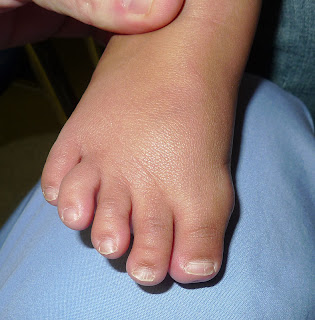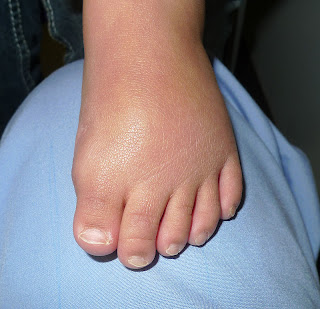Toe Polydactyly
I am a congenital hand surgeon and, therefore, treat children with birth abnormalities of the upper extremity. However, because abnormalities of the feet, including extra toes and toe syndactyly, are similar to hand anomalies, I also treat children with some birth differences of the feet.
Toe polydactyly (extra toes) is less common and also less of a problem than extra fingers. In some instances, extra toes can be ignored. However, if the extra toes affect the width of the foot, wearing shoes can be a problem. If shoe wear is difficult, removal of the extra toes is recommended to narrow the foot.
This case demonstrates a relatively minor extra toe next to the 3rd toe. There is also a partial syndactyly between the great toe and the second toe.
 |
| Toe polydactyly |
This child has a more significant extra great toe on each side preventing shoe wear.
 |
| Severe manifestation of extra great toe |
 |
| The other foot with great toe polydactyly |
This was treated prior to standing/ walking and by 12 months of age, the child was able to wear shoes.
 |
| Scar after correction of polydactyly of great toe. |
 |
| View of foot after correction of polydactyly |
 |
| Other foot after polydactyly treatment. |
What is the total recovery time for a toe removal surgery? My 9 month old daughter has severe manifestation of the great toe on both feet. We have a surgery coming up in a couple of days. I'm curious to know how long she will be in bandages and when she could start wearing shoes.
It is difficult for me to predict. One factor is whether or not a pin will need to placed to reconstruct the toe which not removed. If so, my protocol is casting for 5-6 weeks and then cast removal and pin removal. If not pin is required, progress is much faster.
Shoe wear also depends on the above. The goal is 8-10 weeks but again is quite variable.
Good luck.
This comment has been removed by a blog administrator.